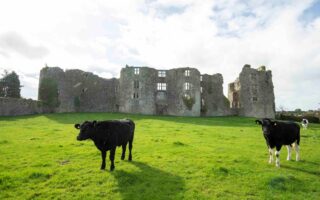Roscommon Castle-South West Tower
A dramatic and imposing thirteenth Century Norman Castle
Closed
Site Closed
Guided weekend tours of the castle ceased on 14 September 2025
Roscommon Castle-South West Tower
The location of Roscommon Castle was both strategic and symbolic. Connacht was one of the last Irish kingdoms to fall under Anglo-Norman rule after their invasions of the late 12th century. The powerful Ó Conchobair (O’Conor) kings had fought, and politically manoeuvred, with the invaders in the decades following the invasions. By the 1260s, the Anglo-Normans were locked into a deadly conflict with Aedh, son of Felim Ó Conchobair, the last King of Connacht. One of the traditional Ó Conchobair power bases was a crannóg here, on Loch na nÉan (Loughnaneane or Lough Nea) that translates to ‘the lake of the birds’. This was a place steeped in myth and legend. A key character in the famous epic Táin Bó Cúailgne, Fergus Mac Róich, King of Ulster, is said to have been buried on the shores of the lake. It was also said to be an entry point to the Otherworld. The decision to site an Anglo-Norman royal castle in this storied landscape, right next to the ancestral home of the Ó Conchobairs was a highly symbolic act indeed.
However, less than a century after it was completed, the O’Conors took possession of Roscommon castle in 1340 and held it for nearly two hundred years. However, in 1569, the castle was surrendered to the English. It was later granted to Sir Nicholas Malby in 1578, who spent a vast sum of money modernising the castle to make it fit for a member of the Tudor elite. You can see evidence for this process of modernisation in the large rectangular windows, particularly visible in the north-east of the castle. He also built an extensive walled garden, fishponds and a grand tree-lined avenue which led to Roscommon town.
Roscommon Castle was under siege by Hugh O’Donnell during the Nine Years War in 1596, and again in 1599. The castle was also attacked during the Confederate Wars of the 1640s. The bloodshed didn’t end there, as Oliver Cromwell’s forces seized the castle in 1652 and destroyed the fortifications. A fire in 1690 did severe damage to the castle and it was left to fall into disrepair through the 18th and 19th centuries.
Gallery

Lake view of Roscommon Castle Credit Photographic Archive, National Monuments Service, Government of Ireland 
Roscommon Castle Exterior Credit Photographic Archive, National Monuments Service, Government of Ireland 
View of Roscommon Castle and Footbridge from Loughnaneane Park Credit Photographic Archive, National Monuments Service, Government of Ireland
Opening Times
31 May – 14 September
**Saturday and Sunday only**
10:00- 17:00
We recommend planning to spend 1.5 hours here.
Notice
Partial accessibility for people with limited mobility.
Children must be supervised at all times.
Getting Here
From the square in Roscommon town head north and take the exit for Castle street. Take a left down Castle Lane, parking is available on this street and the castle is a short walk.
Public Transport:
The Castle is situated just over 20 minutes walking distance away from the Roscommon Train Station. The Dublin Heuston – Wesport & Ballina service stops here at least three times a day in both directions, throughout the week.
Click the relevant icon below to open Maps directions
Facilities
- Car park
- Dogs allowed
- Playground
- Walking trails
Restrictions
- Challenging Access
- Children must be accompanied by an adult at all times
- Limited Access
- No climbing
Nearby sites to visit
Roscommon Castle-South West Tower
Rathcroghan Visitor Centre
Follow in the footsteps of Queen Medb at Connacht’s ancient capital
Approx. 16.6 km from Roscommon Castle-South West Tower
Corlea Iron Age Roadway and Visitor Centre
A pathway into the past
Approx. 23.1 km from Roscommon Castle-South West Tower
Clonmacnoise Monastic Site
A spectacular monastery on the banks of the river Shannon
Approx. 36.8 km from Roscommon Castle-South West Tower

